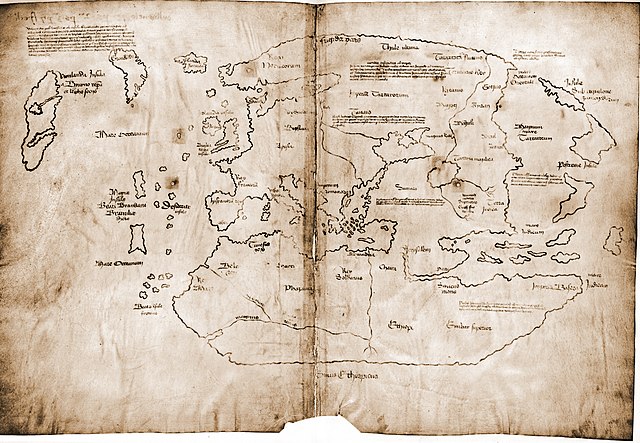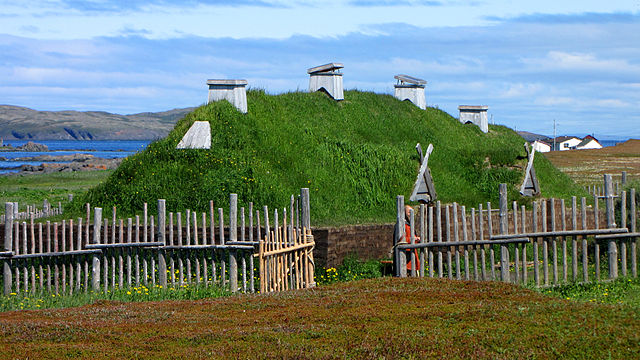
On Friday I was flown to New Haven, CT to tape an interview for a special on the Yale Vinland Map, a disputed document that purports to show North America and to date from around 1440 — around a half-century before Columbus “found” the place.
To say that being interviewed was a surprise would be an understatement. For one thing, it was a rather sudden development: I was first contacted by the television folks eight days before they were flying me off to New Haven. For another thing, though, it was surprising because, well, I don’t consider myself a great expert on the Vinland Map. Not in the way that I think myself an expert on other subjects, to be sure.
So why was I being filmed?
Well, that’s an interesting story.
Over a decade ago, I took a graduate seminar at the University of Rochester under the direction of the very excellent Prof. Tom Hahn. I believe it was called “Production of the Other,” and I found the texts we read about the discovery of the Americas to be especially fascinating. We read a lot of articles about the sources, too, of course, and in one of them there was discussion of a map made by Robert de Popilton, a fairly run-of-the-mill monk living in Hulne in the 14th century.
The author of this article was John Block Friedman, a rather famous scholar in the biz, and he was of the opinion that the Popilton map depicted an ethno-centric depiction of the UK. It turns out he was wrong on this point — what he thought was the UK is only an outline of the Mediterranean Sea — but I was more fascinated by the fact that in the lower left corner of the map that was reproduced for the article there were a number of words visible, hanging out in the space that would be the north Atlantic. One of these appeared to read “Vinland.”

That, of course, didn’t seem possible. Vinland was the name given to parts of North America visited by Norse sailors (you probably know them as Vikings) from Greenland around the year 1000. They built at least one settlement here, at L’Anse aux Meadows, but they didn’t stay more than a couple of decades at most. According to mainline history, knowledge of these discoveries was lost (or never even available) to Continental Europeans. Indeed, the assumption that no one in Europe could really know about Vinland has been one of the (many) reasons to figure the Yale Vinland Map is a fake.
And yet here — right on the edge of this very much authentic fourteenth-century map — was Vinland.
I resolved to find out how this could be possible.
In the end, I was able to identify Vinland in textual descriptions from a multitude of medieval texts, including one in Higden’s Polychronicon, a kind of bestselling encyclopedia for its time. Even better, I found Vinland on more than a half-dozen additional maps of the mid-fourteenth century. All of it more than 150 years before Columbus “sailed the ocean blue.” Pretty fun stuff.
The results of this search became my term paper (got an A!). Then that term paper became an article published in the Journal of Medieval History.
And that article, all these years later, somehow came to the attention of these filmmakers and netted me a trip to New Haven and some face-time on camera. A strange journey, to say the least!

The final show, if I understand correctly, will eventually air on the Smithsonian Channel here in the States, History in Canada, Discovery in the UK, and other such education channels elsewhere.
Looks like I might just have to get cable …

Congrats on your big break into show-biz, Mike. 🙂
Thanks, Cathy! I hope it is the first of many.
Please let us know if you hear when the show will be aired.
Very interesting stuff, but I genuinely don’t think the Vinland Map controversy will be running for much longer. There are one or two important discoveries due to be announced in the next few months…
@JP Exciting, JP! I hope to learn more about these discoveries soon.
I will say, though, that even if someone found “proof” one way or another it might not settle things — especially if it is proof that it is a forgery. Some folks seem to have a ready explanation (“It’s a conspiracy!”) for just about anything that goes against their pre-ordained point of view.
As I said during my interview, I’m of the opinion that the Yale Vinland Map is probably not authentic, but that the essential information that it preserves isn’t terribly far-fetched.
At least that’s my opinion right now. Perhaps these upcoming announcements will force me to reconsider it all!
Well, when I say ‘announcements’ what I really mean is this: I’ve made some discoveries which I do think will finally lay the matter to rest, and hope to publish them (online, at least) very soon. I know where the documents were pre-1957, and a few other things that I can’t be too specific about yet without giving it all away. But what you said in the interview sounds very sensible!
Very, very intriguing. I’m quite anxious to hear about it once the cat’s out of the bag!
Regarding that release, may I suggest that you not publish it online but rather put it through traditional peer-reviewed channels? If it’s important it needs to go through review so that it’ll be taken seriously.
In fact, I think I’m going to write a post on that difference. It’s come up a couple of times recently.
And if you need any advice on that process, drop me a line through the contact page.